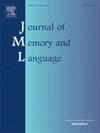Exploring the animacy effect in focal prospective memory tasks: When animates don’t stand out
IF 3
1区 心理学
Q1 LINGUISTICS
引用次数: 0
Abstract
The animacy effect refers to a memory advantage for animates/living beings as compared to inanimates/nonliving things. So far, the animacy effect has been investigated mostly in retrospective memory. Given that memory serves a future-oriented function, and considering the adaptive significance of animacy, it has been proposed that it should also confer an advantage in prospective memory (i.e., memory for intentions/actions to-be-performed in the future). Recent research reported an animacy effect in nonfocal event-based prospective memory tasks. The present work explored this effect in focal prospective memory. In a series of five studies, conducted in different countries and languages, we employed various ongoing tasks. Across all studies, no differences in prospective memory performance between animates and inanimates were found. This result held in a sign-test including all participants (N = 408 young adults) for a more powered analysis. Also, no differences between animates and inanimates were obtained in the baseline and filler trials. These results are discussed considering the mechanisms that have been proposed to explain the effect in retrospective memory tasks, namely attention-prioritization and richness of encoding. Overall, our results are partially explained by the attention-prioritization account of the animacy effect and also provide support for the Multiprocess Framework.
探究焦点前瞻记忆任务中的动画效果:当动画不突出时
有生命效应是指有生命/生物相对于无生命/非生物的记忆优势。到目前为止,动画效应的研究主要集中在回顾性记忆中。鉴于记忆服务于面向未来的功能,并考虑到动画的适应性意义,有人提出它也应该赋予前瞻性记忆(即对未来将要执行的意图/行动的记忆)的优势。最近的研究报道了在非焦点事件为基础的前瞻性记忆任务中的动画效应。本研究在焦点前瞻记忆中探讨了这种效应。在用不同国家和语言进行的五项系列研究中,我们采用了各种正在进行的任务。在所有的研究中,没有发现动物和非动物在前瞻记忆表现上的差异。这一结果在包括所有参与者(N = 408名年轻人)的符号测试中得到了更有力的分析。此外,在基线和填充试验中,动物和非动物之间没有差异。这些结果讨论了已提出的机制,以解释在回顾记忆任务的影响,即注意优先和编码的丰富性。总的来说,我们的结果部分地解释了动画效应的注意优先级,也为多进程框架提供了支持。
本文章由计算机程序翻译,如有差异,请以英文原文为准。
求助全文
约1分钟内获得全文
求助全文
来源期刊
CiteScore
8.70
自引率
14.00%
发文量
49
审稿时长
12.7 weeks
期刊介绍:
Articles in the Journal of Memory and Language contribute to the formulation of scientific issues and theories in the areas of memory, language comprehension and production, and cognitive processes. Special emphasis is given to research articles that provide new theoretical insights based on a carefully laid empirical foundation. The journal generally favors articles that provide multiple experiments. In addition, significant theoretical papers without new experimental findings may be published.
The Journal of Memory and Language is a valuable tool for cognitive scientists, including psychologists, linguists, and others interested in memory and learning, language, reading, and speech.
Research Areas include:
• Topics that illuminate aspects of memory or language processing
• Linguistics
• Neuropsychology.

 求助内容:
求助内容: 应助结果提醒方式:
应助结果提醒方式:


